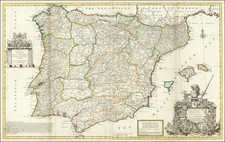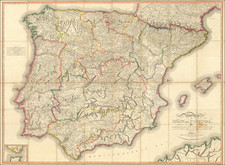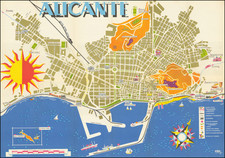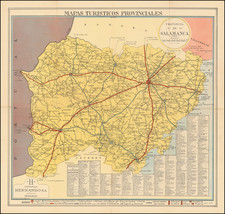A 16th-century view of "Velis Malaga" by Braun & Hogenberg, this illustration was once part of a larger folio sheet that incorporated additional views. The rendering showcases the Spanish town of Vélez-Málaga with the Sierra Tejeda as its backdrop. Dominating the scene is the imposing Moorish castle, constructed in the 13th century, perched on a hill, underscoring the region's rich historical influences.
Braun's commentary on this view serves as an invaluable resource, shedding light on the town's geographical and historical context. He highlights the town's strategic location, situated a mere half a mile from the Mediterranean and in the vicinity of the main city, Málaga. The castle, with its ancient Moorish roots, stands as a testament to the town's historical layers.
The commentary further amplifies the unique geographical features of Vélez-Málaga. The surrounding mountains are cited as being so steep and high that one can glimpse the Herculean Sea, several towns in the Barbary Coast, and the African cities of Ceuta and Tangier. This implies the significant strategic vantage point the town held during this period.
Vélez-Málaga had a dynamic past. The town underwent various transformations, from Roman times to Moorish rule, and later under the reign of Ferdinand III. Presently, it stands as an integral part of the popular Costa del Sol, revealing a fascinating transition from a strategic fortress to a bustling tourist hub. This view by Braun & Hogenberg, therefore, is a valuable visual record of Vélez-Málaga's historical and geographical evolution.
Georg Braun (1541-1622) was born and died in Cologne. His primary vocation was as Catholic cleric; he spent thirty-seven years as canon and dean at the church St. Maria ad Gradus, in Cologne. Braun was the chief editor of the Civitates orbis terrarum, the greatest book of town views ever published. His job entailed hiring artists, acquiring source material for the maps and views, and writing the text. In this role, he was assisted by Abraham Ortelius. Braun lived into his 80s, and he was the only member of the original team to witness the publication of the sixth volume in 1617.
Frans Hogenberg (ca. 1540-ca. 1590) was a Flemish and German engraver and mapmaker who also painted. He was born in Mechelen, south of Antwerp, the son of wood engraver and etcher Nicolas Hogenberg. Together with his father, brother (Remigius), uncle, and cousins, Frans was one member of a prominent artistic family in the Netherlands.
During the 1550s, Frans worked in Antwerp with the famous mapmaker Abraham Ortelius. There, he engraved the maps for Ortelius’ groundbreaking first atlas, published in Antwerp in 1570, along with Johannes van Deotecum and Ambrosius and Ferdinand Arsenius. It is suspected he engraved the title page as well. Later, Ortelius supported Hogenberg with information for a different project, the Civitates orbis terrarium (edited by Georg Braun, engraved by Hogenberg, published in six volumes, Cologne, 1572-1617). Hogenberg engraved the majority of the work’s 546 prospects and views.
It is possible that Frans spent some time in England while fleeing from religious persecution, but he was living and working in Cologne by 1580. That is the city where he died around 1590. In addition to his maps, he is known for his historical allegories and portraits. His brother, Remigius, also went on to some fame as an engraver, and he died around the same time as his brother.










![[ Vejer de la Frontera and Vélez-Málaga ] Vegel / Velis Malaga](https://storage.googleapis.com/raremaps/img/small/77661.jpg)
![(Iberian Peninsula) Hispaniae et Portugalliae Maritimi Tractus Pascaert van Spangie, en Portugal [Sea Chart of the Coastal Areas of Spain and Portugal]](https://storage.googleapis.com/raremaps/img/small/93876.jpg)


